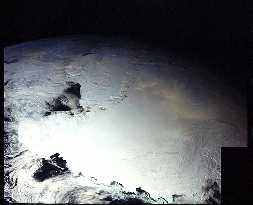This image shows spectral information collected from the Earth's moon.
Click on image for full size
NASA
Spectra
Minerals of a planet's surface, and molecules of an atmosphere emit light of various wavelengths. The wavelengths of light which minerals or molecules emit is characteristic of each individual mineral or molecule, and is called that mineral or molecule's
spectra. Thus the spectra of a mineral or molecule is like a human fingerprint, and can be used to identify it.
When studying the planets, scientists have designed instruments which can collect separate wavelengths of light. The light received from a planet is separated by means of a mirror or several mirrors, into separate wavelengths. Instruments such as these help scientists determine what a planet is made out of. Such an instrument is called a spectrometer.
The image to the left of the Earth's moon was made by examining the moon through different wavelengths of light, then recombining them into one picture. Some minerals emit more light in the blue than the red, and so on. These minerals stand out in the picture. The colors of the picture are enhanced to better show the contrast. Pink is very old, pulverized terrain, oranges and blues are lunar lava flows composed of granite-like rock, light blue are mineral-rich deposits associated with meteorite impacts.
You might also be interested in:

To date, 76 extrasolar planets are known. Yesterday, the first detection of an extrasolar planetary atmosphere was announced! As well, this is the first chemical analysis to be done on the atmosphere of
...more
The Mars Odyssey was launched April 7, 2001, from Cape Canaveral Air Force Station in Florida. After a six-month, 285 million-mile journey, the Odyssey arrived at Mars on October 24, 2001 (02:30 Universal
...more
Mars Global Surveyor (MGS) is conducting mapping operations at Mars more than 30 years after America's first reconnaissance missions reached the mysterious red planet. Here are some of the instruments
...more
The Mars Pathfinder was launched in December 1996 aboard a Delta II rocket. The spacecraft entered the Martian atmosphere on July 4th, 1997 with a Viking-derived heat shield and landed with the help of
...more
Pluto is so far away, and has never been explored. Questions to answer about Pluto include the following: What are the geologic features of the surface. (pictures of the surface) If there are bare spots,
...more
AU stands for Astronomical Units. Distances in space are too large to measure in Earth standards like miles or kilometers. For distances too large to measue in AU, we use light years. A light year is the
...more
The solar wind is formed as the Sun's topmost layer blows off into space carrying with it magnetic fields still attached to the Sun. Gusts and disturbances form in the solar wind associated with violent
...more















